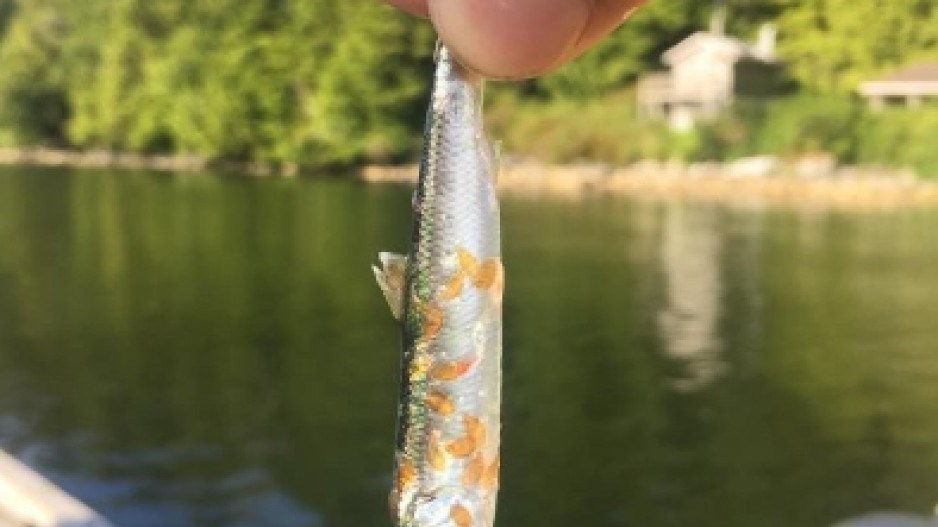Fisheries and Oceans Canada confirms the findings of independent research that says sea lice on salmon farms are becoming resistant to SLICE, a pesticide used to kill sea lice.
It also confirms it is conducting a review of a Cermaq fish farm in Clayoquot Sound to determine whether the company properly followed the protocols for reporting and treating a sea lice outbreak in the spring.
Earlier this week, independent researcher Alexandra Morton and the Living Oceans Society published findings from research that highlights a sea lice outbreak earlier this year at a Cermaq salmon farm in Clayoquot Sound.
The report, Lousy Choices: Drug Resistant Sea Lice in Clayoquot Sound, highlights the fact that sea lice are becoming resistant to SLICE, which is the only pesticide approved for sea lice control in Canadian fish farms.
“The spring of 2018 saw parasitic sea lice on both farmed and wild juvenile salmon in Clayoquot Sound reach levels never before seen in the province of B.C.,” the report states.
It says DFO and the industry have known sea lice were becoming resistant to SLICE since 2014, but have “publicly and repeatedly denied this fact.”
According to the report, high levels of sea lice were found in both wild and farmed salmon in the Clayoquot Sound in the spring of this year.
“Independent monitoring found 96 percent of wild juveniles carried lice, with an average of 8.04 per fish,” the report states.
The report says that one to three sea lice can kill a juvenile salmon.
Sea lice infestations can occur naturally in the wild, but open net salmon farms can concentrate outbreaks because the fish are so densely crowded together. Wild salmon swimming near the open net pens can then be exposed to high concentrations of the parasite.
Over the winter of 2017 and spring of 2018, salinity levels that normally drop with increased rain did not occur, Dan Bate, communications lead for Fisheries and Oceans, Pacific region said in an email.
“This higher salinity resulted in increased lice production in the region and exacerbated the lice levels on farms,” Bate wrote.
When infestations occur, fish farmers have typically used SLICE to treat the infestation, although they have more recently also begun using hydrogen peroxide. But sea lice are becoming resistant to SLICE in some instances, DFO confirmed.
Earlier this year, DFO sent sea lice samples to the BC Centre for Aquatic Health Sciences, which confirmed SLICE resistance in the lice.
It’s not the first time that infestations have occurred where SLICE appears to have not worked to control sea lice. Bate said there have been “documented failures of SLICE treatment” in 2013 at Klemtu and in 2017 in Esperanza Inlet.
SLICE is currently the only pesticide approved for treating sea lice in Canada.
“Research is under way, by DFO, industry, and academia, to find alternative methods to manage sea lice, and to better predict and track SLICE resistance,” Bate wrote.
Alternative treatment technologies include thermolicers, which bathe infected fish in warm water, and hydrolicers, which uses pressurized water to wash the lice off the fish.
Marine Harvest has recently brought in a hydrolicer, which it has used once, and in 2019 will also bring in a fresh water bath system, which kills lice simply by exposing them to fresh water.
Given how long DFO and the industry have known about SLICE’s declining efficacy, those types of alternative treatments should have been in place already, said Karen Wristen, executive director for the Living Oceans Society.
“What they should have been doing is having the bath treatments lined up sooner and they didn’t,” Wristen said.
“Going forward the concern is equally dire – that we’re going to be using a lot of chemical that will just dump holus bolus into the ocean. Hydrogen peroxide is toxic to all forms of crustaceans and so will have an impact locally and temporarily on crustaceans.”
Wristen added that sea lice can also become resistant to bath treatments, if not used correctly.
Jeremy Dunn, public affairs director for Marine Harvest, agrees. Sea lice can become resistant to various treatments, if that's the only treatment that is used, which is why the industry is starting to use multiple tools for pest management.
Just as some strains of bacteria can become resistant to drugs like amoxicillin, that doesn't mean amoxicillin won't work on other strains. Similarly, not all sea lice are resistant to SLICE. The resistance develops when SLICE is overused in a particular area, and the lice develop resistance to it.
But as wild fish introduce “naïve” populations of sea lice that have never been exposed to SLICE into an area, those lice may not be resistant. And in that case, SLICE may still be an effective pest management tool, Dunn said.
“If you rely on one product only, you will invariably drive resistance," Dunn said. "You have to have an integrated approach.”
Marine Harvest now has three lice control tools, and plans to add a fourth in 2019 – a fresh water bath system.
“We’ll have gone from one tool in 2013, to four tools in 2019," Dunn said.
Another alternative that the industry is exploring is using indigenous fish, like ocean perch, which will naturally feed on sea lice like cleaning wrasse.




